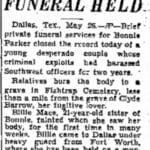The Grisly Reality of Bonnie Parker’s Death
Bonnie and Clyde. The names echo through history, synonymous with Depression-era outlawry and daring escapes. However, the romanticized image often portrayed clashes starkly with the brutal reality of their demise, particularly Bonnie Parker’s. Her autopsy report, a chilling document detailing the extent of her injuries, reveals a tragic end far removed from Hollywood’s glamorous portrayals. Let’s delve into the medical examiner’s findings and separate fact from fiction.
On May 23, 1934, Bonnie and Clyde’s crime spree met a bloody end on a Louisiana back road. Dr. J.L. Wade, the coroner, meticulously documented the injuries Bonnie sustained in the police ambush. His report serves as a stark reminder of the violence that punctuated their lives.
Key Points from Bonnie Parker’s Autopsy Report:
- Head and Neck: At least 26 bullet wounds ravaged Bonnie’s face, neck, and chest. This likely suggests she faced the onslaught head-on.
- Left Arm: Nine gunshot wounds riddled her left arm, possibly indicating a defensive posture.
- Fatal Blow: A single bullet to the right temple ended her life instantaneously, suggesting a close-range shot, perhaps even a coup de grâce.
- Debunking the Myth: The sheer number of wounds points to a merciless ambush, not a romanticized shootout.
- Forensic Significance: The report confirms the violent nature of the ambush, corroborating the official police account.
- The Human Element: Beyond the statistics lies a young woman whose life ended tragically.
- Ethical Considerations: Respect for the deceased is crucial when examining and discussing such sensitive details.
Bonnie Parker’s Limp: A Gruesome Reality Behind the Outlaw Legend
The Bonnie and Clyde saga often overshadows the harsh realities they faced. One such reality was Bonnie’s pronounced limp, a constant reminder of a horrific car accident. This wasn’t a minor inconvenience; it significantly impacted her life and likely contributed to their downfall.
On June 10, 1933, Clyde, driving recklessly, crashed their car. While broken bones certainly occurred, the true culprit behind Bonnie’s limp was far more horrific: battery acid. During the crash, battery acid spilled onto Bonnie’s leg, burning her flesh deeply, reportedly “all the way to the bone.” This catastrophic injury left her with a permanent limp, severely limiting her mobility.
This accident marked a turning point. Bonnie’s constant pain and reduced mobility likely increased their vulnerability. Clyde frequently had to carry her, a poignant illustration of their dependence on each other. The limp became a symbol of their diminishing freedom and escalating risks. It humanizes Bonnie, reminding us of the immense hardship she endured. Some historians even suggest her injury played a role in their eventual capture.
While some details of their lives remain debated, the battery acid accident and its impact on Bonnie’s mobility are generally accepted. This detail underscores the grim reality behind the romanticized narrative. Ongoing research continues to explore their motivations and the ultimate consequences of their actions, seeking to understand the complexities of these infamous figures. Did you know that the bonnie and clyde funeral attendance was a shocking display of public outcry against the romanticized outlaws?
Did Bonnie Parker Have a Husband? The Untold Story Before Clyde
Before Clyde Barrow, there was Roy Thornton. Bonnie Parker’s marital history, often overlooked, adds another layer to her complex story. At the young age of 15 (almost 16), Bonnie married Roy Thornton in 1926. Their relationship, however, proved tumultuous, and they separated shortly after. They briefly reconciled and remarried in 1928, only to separate again the following year.
In 1929, Thornton’s imprisonment for robbery marked a definitive end to their relationship. A significant detail often overlooked is that despite their separation and Bonnie’s subsequent relationship with Clyde, she and Thornton never officially divorced. Throughout her time with Clyde, Bonnie remained legally Mrs. Thornton.
Bonnie met Clyde around 1930, and their infamous partnership began. Their criminal exploits, spanning from 1932 to 1934, captivated the nation. Through it all, Bonnie remained legally bound to her imprisoned husband. This detail offers a glimpse into the complexities of her personal life beyond the headlines.
This raises several questions. Did she ever consider Roy during her time with Clyde? Did she regret how things turned out? We can only speculate. This unexplored aspect of her life might offer valuable insight into her motivations and character. And did you know that The countess of Castiglione was a beautiful and influential figure in 19th-century European society?
- Unlock Water’s Symbolism: A Cross-Cultural Exploration - April 20, 2025
- Identify Black and White Snakes: Venomous or Harmless? - April 20, 2025
- Unlocking Potential: Origins High School’s NYC Story - April 20, 2025
















1 thought on “Bonnie Parker’s Autopsy: Unraveling the Myths and Grisly Truths of the Outlaw’s Demise”
Comments are closed.